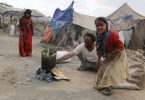Earlier this month the hospital issued a distress call to the government to help treat the thousands of patients visiting every day. “There are more than 100 cases of malnutrition in Hodeida,” Abdulmoghni told 7DAYS.
“The children need drugs for malnutrition and we should take them to hospitals in Sana’a as soon as possible.”
Among the cases is that of Salim Musabih, a six-year-old boy who was brought to the hospital in an emaciated state. Photos of Salim, who comes from the one of the worst-hit areas, the Taheita district, went viral and brought the plight of the city and its surrounding areas into the global spotlight, as reported by 7DAYS last week.
RELATED: Starving child exposes ‘forgotten crisis’ in Yemen
Abdulmoghni said that much of the equipment is ruined due to poor maintenance, leaving the hospital ill-equipped to deal with the 2,000-plus patients who visit each day and the medical needs on the whole of the governorate’s 400,000 population.
“Lots of medical conditions enter Al Thawra Hospital,” he said.

“The common sickness for children is malnutrition while old and young people often have infectious diseases and skin diseases. Al Thawra Hospital cannot deal with all the medical conditions because of a lack of supplies and most of medical equipment is ruined from poor maintenance.
“It is the only hospital in the governorate and 80 per cent of the equipment is off. It has no doctors, no experienced nurses, no pharmacists.”
Hodeida fell under the control of Houthi rebels soon after the capital Sana’a fell in 2014. The city is a major supply route of food imports into the country, but has been cut off by a naval blockade imposed by the exiled Yemen government since April 2015, restricting commercial and humanitarian imports, according to a UN Security Council report.
As a result of the lack of food supplies and the growing poverty caused by the conflict, more than 100,000 children are in desperate need of food in Hodeida alone, a spokesman from UNICEF told 7DAYS last week.
Abdulmoghni said the breakdown of the state after more than 18 months of fighting has also led to the collapse of medical infrastructure throughout the country.
The damage to oil infrastructure in the fighting and withdrawal of international oil companies has led to a scarcity of fuel for air conditioning and electricity, compounding the medical crisis, he added.
“Infectious diseases and skin diseases are common as a result of the high, hot temperatures and power outages in the city, which causes increased body temperature and sweating. That’s why the skin diseases are widespread in that city.”
The situation in Hodeida deteriorated rapidly with the onset of war, he said.
“[The area] is completely under Houthi control, but this is not the reason for this bad situation,” he added after returning to Sana’a from the visit.
“Al Hodeida has been bad for the last 35 years, but the situation of this governorate became worse after the war, especially at the end of 2015.” Fuad Rajeh, a Yemeni journalist based in Sana’a, said the naval blockade may have stopped the inflow of weapons to Houthis but it has caused a medical crisis throughout the country.
“Many hospitals have run out of medicines and necessary medical supplies. The healthcare system in Yemen has deteriorated largely, and WHO [the World Health Organisation] is warning it is on brink of total collapse,” he said.
“Most hospitals have shut down amid acute shortages of medicines and other supplies, including fuel.”
Read the original story at: Inside Yemen’s hospitals under the strain of war







